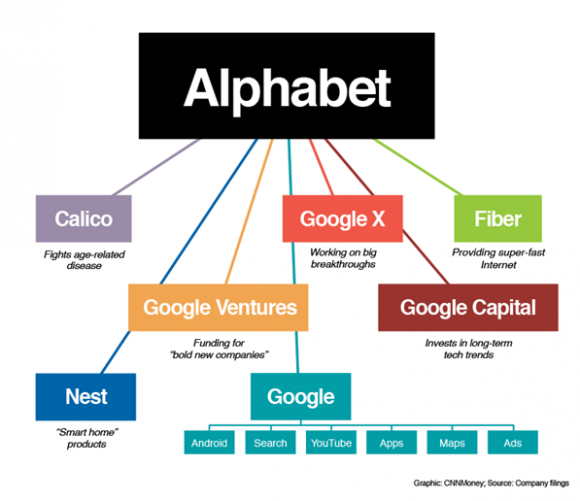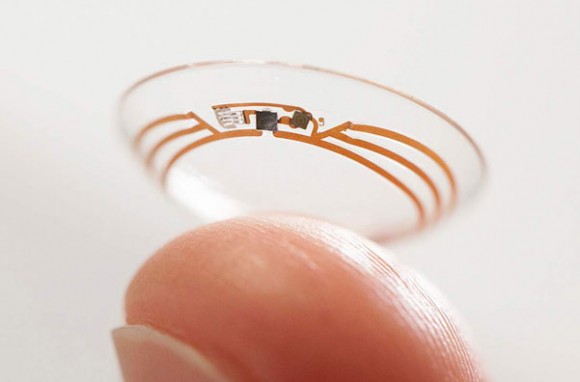G is for Google and X is for Groundbreaking Healthcare
According to Forbes’ 2015 rankings, Google is one of the world’s biggest public companies with 66 billion in sales, 10.7 billion in profit, and boasts a market value of $71.2 billion. Google ranks as the #3 World’s Most Valuable Brand and has captured the #1 position for America’s Best Employer. The Google Guys, Larry Page and Sergey Brin, (the Inventors) are worth 30 billion each, even though their annual salary is a dollar (World’s Most Valuable Brands, Forbes.com).
Recently, Google announced that Alphabet will be its new parent company. G is for Google, of course. Although it’s not likely that Alphabet will coin a company for each letter of the alphabet, the umbrella name does imply that a variety of companies will be a part of this new structure. Google just happens to be the largest and most well-known.

Alphabet showcases to the world that Google offers a whole lot more than a world-class search engine, web browser, mapping application, and Android technology.
Google is crazy about the “life sciences.”
Google X labs – now referred to as “X” is a mysterious lab that works on all those high-tech things and inventions that only sci fi movies are made of. Some of these inventions are already household words; driverless cars, Google Glass, high tech contact lenses, and drone delivery. X is even more exciting because it has a very secretive and mysterious aura about it. There’s no address for X and it’s only reported to be somewhere in the Bay Area of California. Rumor has it that “robots run free” at X. At X, the “future is being imagined” (Google’s Lab of Wildest Dreams, NYTimes.com). The objective for all employees is to tackle a list of “100 shoot-for-the-stars ideas.” Pretty cool, eh?
Bill Maris, head of Google Ventures predicts that humans, someday, will live to be 500 years old because of Google’s scientific innovations and discoveries. Now that is a wild prediction, but considering all that Google has accomplished so far, hey…this could be true someday!
Let’s take a look at three ground-breaking products at X that are going to change the healthcare industry forever.
1. X Marks the Spot in Cancer Research
X Labs has filed patents with the World Intellectual Property Organization for a wearable device (a wristband) that helps destroy cancer cells in the blood of cancer patients. The wrist-worn, “disease-detecting magnetic nanoparticle” wearable transmits energy into the blood vessels to reduce and eliminate cancer cells. Can you imagine? Get your chemotherapy by donning a wristband?
Although X admits that they are at least five years away from marketing this product, it has been busy investing in partners and identifying start-ups to help them make this invention a reality. X is even developing “a cancer detecting pill that would contain tiny magnetic nanoparticles that would travel through a person’s bloodstream and search for cancerous cells.” X is all about treating diseases and illnesses that have plagued mankind throughout history like cancer, kidney disease and heart attacks. These kinds of groundbreaking clinical innovations would not be “consumer devices” but “prescriptive medical devices” (Google is developing cancer and heart attack detector, BBC.com). If they ultimately fail or come to fruition, X is proof that Alphabet is dead serious about diving into the healthcare field.
2. X Marks the Spot in Smart Contact Lenses
X is also working on creating contact lenses with an embedded chip that can monitor blood sugar for people with diabetes. Now that’s smart contact lenses! Google has been working with the FDA to test various prototypes. They feel that since diabetics must prick their fingers and test their blood sugar levels throughout the day, having contact lens that automatically tested their blood sugar would be extremely convenient if not completely non-invasive. X is also investing in contacts that will offer its wearer an autofocus feature. Similar to digital cameras that bring a scene into clear focus, X’s autofocus contact lenses hope to address a range of eye issues that would otherwise require the person to wear glasses.

Google’s smart contact lenses. Image courtesy of Time.com.
3. X Marks the Spot in Google Glass
Also known as Project Glass, this wearable technology was introduced in 2013 and even before it was marketed mainstream, Time Magazine named Glass one of the “Best Inventions of 2012.” Although Google Glass appears to be glasses because they rest on your ears, they really aren’t glasses because there are no lenses. So what can you do with these glasses that, by the way, cost $1500?
Google Glass allows its wearer to surf the Internet, get directions, send emails, take pictures, record video as well as call someone. Its ability to do these things relies on its Wi-Fi system, Bluetooth and a micro USB. The prism – aka the actual computer – is very tiny and affixed to the right hand side of Glass. Looking through Glass (on the right hand side), you would see a small display that functions as your desktop or computer screen. Google says that the screen is meant to mimic a 25-inch monitor display but from 8-feet away. The screen will not occlude one’s vision. Although the sales of Google Glass were troubling and were much lower than expected, it led Google to suspend and end the sales of Glass – for now.
Glass and Telemedicine
However, there was a target market that did not turn its back on Glass – major hospitals “have been experimenting with the use of Google Glass since the first prototype was released in 2013” (How Google Glass Could Save Lives In The Hospital ER, Huffingtonpost.com).
For example, a team at the University of Massachusetts Memorial Medical Center in Worcester is using Google Glass to diagnose suspected poisoning in patients. Using Glass allows the doctor to go to the patient’s bedside and record video, take pictures and capture audio to share with remote toxicology experts. This form of “telemedicine” shows great promise because specialists and experts are not situated in each and every hospital. Having Glass available to doctors lets them share their patients’ information and symptoms quickly and securely.
Spot-On Searches
Google X is making sure that the Google search is keeping up with the healthcare craze by providing a more robust, spot-on search. Since “1 in 20 Google searches” are health related, Google has made further adjustments to its algorithm and has introduced more authoritative health-related search results. In other words, search results will present more results from genuine doctors, offering “much needed validity to the world of health-related searches” (Google Will Make Health Searches Less Scary With Fact-Checked Results, Wired.com).
According to Andrew Conrad, a genetics expert hired by Google to run their Life Sciences Team, “Google’s mission is to make the world’s information useful.” And providing users with validated or authoritative search results, when it comes to health issues, makes sense.
All of Alphabet’s amazing projects and initiatives show us that we are limited only by our imaginations.
Sources:
http://www.forbes.com/companies/google/
http://www.nytimes.com/2011/11/14/technology/at-google-x-a-top-secret-lab-dreaming-up-the-future.html?_r=0
http://www.wired.com/2015/02/google-health-search/
http://hitconsultant.net/2015/03/04/infographic-how-does-google-plan-to-transform-healthcare/
http://www.bbc.com/news/technology-29802581
http://time.com/3758763/google-smart-contact-lens/
http://www.prnewswire.com/news-releases/google-novartis-and-epgl-in-race-to-develop-first-autofocus-contact-lens-300116881.html
http://blogs.wsj.com/digits/2014/12/15/google-ventures-shifts-focus-to-healthcare/


.png)
